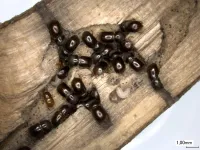(Press-News.org) University of Cincinnati Cancer Center researchers will present more than a dozen abstracts at the American Association for Cancer Research Annual Meeting 2023, held in Orlando, Florida, April 14-19, including findings that could advance treatments for head and neck and breast cancers.
Enzyme shows promise as target to treat HPV negative head and neck cancer
Vinita Takiar’s lab in UC’s Department of Radiation Oncology studies how to improve radiation therapy for head and neck cancer patients.
Julianna Korns, a doctoral student working in Takiar’s lab, and her colleagues study an enzyme called Plk1 that allows healthy cells to divide and function normally. When overexpressed in head and neck cancer cells, it causes the cells to divide abnormally and at a faster rate, leading to the accumulation of more cancer cells.
Using data from The Cancer Genome Atlas database, the research team found Plk1 overexpression was correlated with worse survival outcomes in head and neck cancer patients. Studying cell lines in the lab, they found blocking Plk1 reduces head and neck cancer cell growth.
Interestingly, Korns noted that Plk1 inhibition reduces cell growth in head and neck cancer cells that are positive and negative for HPV, but HPV-negative cells are more sensitive to this treatment than HPV-positive cells.
“Typically, HPV-negative head and neck cancer patients are more resistant to therapy, so this novel finding could provide benefit to HPV-negative head and neck cancer patients in the clinic,” Korns said. “Our study indicates a potential marker for treatment outcomes. Understanding the role of Plk1 is pivotal to optimizing treatment regimens for these patients.”
Korns said the team plans to translate its preclinical findings into clinical settings, targeting Plk1.
“Our findings may provide a novel target for head and neck cancer therapy in combination with radiation, implementing the bench to bedside mentality to improve patient outcomes and reduce toxicities related to current treatments,” she said.
Plk1 signaling as a therapeutic target for HPV-head and neck cancer will be presented by Korns April 17 from 1:30-5 p.m. during the Radiosensitizers and Radio-immunomodulators poster session. Co-authors include Takiar, Trisha Wise-Draper and Samuel Thompson.
Protein a potential new target for breast cancer treatment
Researchers in Jun-Lin Guan’s lab in UC’s Department of Cancer Biology found a potential combination treatment target for breast cancer cells and breast cancer stem cells.
Kanakaraju Manupati, PhD, postdoctoral fellow in Guan’s lab, researched a protein called NuMA1. The protein is known to be upregulated in breast cancer, but the specific role it plays within tumors of breast cancer subtypes was not well-defined.
Manupati’s research found that when NuMA1 was deleted in animal models of three different breast cancer cell lines, it reduced tumor growth. Removing NuMA1 from breast cancer stem cells led to reduced metastasis, or cancer spread, suggesting it plays a role in cancer growth and spread in both breast cancer bulk and stem cells.
“The interesting finding is that we observed that NuMA1 depicted various roles in different subtypes of breast cancer,” he said.
There are currently no drugs that directly target NuMA1, but it is regulated by an enzyme called PIM1. The research team tested the effectiveness of a drug that blocks PIM1 and found the enzyme inhibitor reduced tumor formation and cancer spread in all three subtypes of breast cancer they tested.
The treatment was even more effective when combined with an autophagy inhibitor that blocks the cell's process of breaking down nutrients to grow and thrive.
“When we used this combination approach, we could see there is a significant reduction of breast cancer tumor formation as well as metastasis,” Manupati said.
The knowledge that NuMA1 plays a role in both bulk breast cancer cells and breast cancer stem cells makes it a promising potential target, Manupati said.
“To prevent breast cancer metastasis, we need to kill both breast cancer cells as well as breast cancer stem cells,” he said. “Therefore, we need to target both of these populations to fully prevent breast cancer.”
Moving forward, Manupati said the team hopes to continue studying the potential applications of the therapy approach of using a combination of PIM1 and autophagy inhibitors and how NuMA1 works in a variety of breast cancer stem cells.
Role of NuMA1 in tumor formation and metastasis with implications for combination therapy of PIM1 and autophagy inhibition in breast cancer will be presented by Manupati April 19 from 9 a.m.-12:30 p.m. during the Cancer Stem Cells and Therapeutic Resistance poster session. Study co-authors include Guan, Mingang Hao, Michael Haas and Syn Kok Yeo.
Research finds oncogene overexpressed in head and neck cancer
Susan Waltz, PhD, studies the role of a gene that helps accelerate cancer growth called Ron in her laboratory in UC’s Department of Cancer Biology. Zhixin Lu, a doctoral student in Waltz’s lab, wanted to learn more about how Ron affects head and neck cancers while on a rotation in Takiar’s lab.
Lu’s research bridges a collaboration between the Takiar and Waltz laboratories and between UC departments.
“We have heavily studied this Ron receptor in breast cancer and prostate cancer, how it drives cancer metastasis and drug resistance,” Lu said. “Ron is heavily expressed in a lot of cancers, including head and neck cancer, but we know much less about its role in head and neck cancer. So that’s really the premise of my project.”
Lu’s research found that Ron is overexpressed at high levels in multiple cell lines of head and neck cancer, which she said indicates it may play a role in the cancer cells’ function and growth.
“Ron expression is correlated with worse patient survival outcomes and radiation resistance. The higher Ron is expressed, the less the patient is going to survive in terms of overall survival, which indicates it potentially has a very negative role in those patients,” Lu said. “This makes it a very promising target to study.”
A protein called EGFR is also overexpressed in a majority of head and neck cancers, but anti-EGFR treatments have not been very effective to this point due to the cancers developing drug resistance. Interestingly, the researchers found there is an inverse correlation between Ron and EGFR expression in head and neck cancer cell lines and patient data.
Future studies will aim to learn more about how EGFR and Ron interact and whether blocking Ron will make EGFR-targeted treatments more effective. Lu said the team is also looking to see if there is a similar inverse correlation between Ron and EGFR in breast cancer, which could provide more information on their interaction.
As researchers learn more, Lu said Ron inhibitors could potentially become a more common treatment option for head and neck cancer patients. Current treatments still rely heavily on chemotherapy and radiation, which come with toxicity and side effects, but a small molecule target like Ron could reduce the dose of chemotherapy needed, she said.
“It’s more precise because the small molecule really targets proteins and the oncogenic pathway, and combined with that, may not only reduce the side effect but also be more precise to the specific target,” Lu said.
RON receptor tyrosine kinase in head and neck cancer: a potential target for overcoming resistance to anti-EGFR therapy will be presented by Lu April 16 from 1:30-5 p.m. during the Drug Resistance in Molecular Targeted Therapies 1 poster session. Co-authors on the project include Mathieu Sertorio, Takiar and Waltz.
Other abstracts being presented by Cancer Center researchers include:
FOXA2 induces invasive mucinous adenocarcinoma of the lung in the presence of mutant KRAS, presented by Yutaka Maeda April 17 from 9 a.m.-12:30 p.m. during the Gene Regulation in Solid Tumors poster session.
Pan-cancer splicing analysis reveals shared drivers of malignant transformation and survival, presented by Anukana Bhattacharjee April 17 from 1:30-5 p.m. during the Bioinformatics Applications in Cancer Biology 2 poster session.
Role of her3 v104l mutation on tumor growth and her3 stabilization, presented by Rosalin Mishra April 18 from 9 a.m.-12:30 p.m. during the Identification of Molecular Targets 1 poster session.
RON receptor signaling enhances prostate cancer metastasis in Hi-Myc mice, presented by Angelle D. Jones April 17 from 9 a.m.-12:30 p.m during the EMT and Plasticity poster session.
Identification of resistance mechanisms to direct KRAS inhibition in pancreatic cancer, presented by Andrew Waters April 16 from 1:30-5 p.m. during the Precision Molecular Subtyping and Therapeutic Development poster session.
The role of HER3 mutations in the progression of colon cancer and modulation of drug sensitivity and resistance, presented by Mary K. Kilroy April 18 from 9 a.m.-12:30 p.m. during the Oncogenes and Tumor Suppressor Genes as Targets for Therapy 3 poster session. END
Head and neck, breast cancer research highlights University of Cincinnati AACR abstracts
University of Cincinnati Cancer Center researchers presenting at national conference
2023-04-14
ELSE PRESS RELEASES FROM THIS DATE:
Scientists develop new way to measure wind
2023-04-14
Wind speed and direction provide clues for forecasting weather patterns. In fact, wind influences cloud formation by bringing water vapor together. Atmospheric scientists have now found a novel way of measuring wind – by developing an algorithm that uses data from water vapor movements. This could help predict extreme events like hurricanes and storms.
A study published by University of Arizona researchers in the journal Geophysical Research Letters provides, for the first time, data on the vertical distribution of horizontal winds ...
Ancient DNA reveals the multiethnic structure of Mongolia’s first nomadic empire
2023-04-14
Long obscured in the shadows of history, the world’s first nomadic empire - the Xiongnu - is at last coming into view thanks to painstaking archaeological excavations and new ancient DNA evidence. Arising on the Mongolian steppe 1,500 years before the Mongols, the Xiongnu empire grew to be one of Iron Age Asia’s most powerful political forces - ultimately stretching its reach and influence from Egypt to Rome to Imperial China. Economically grounded in animal husbandry and dairying, the Xiongnu were famously nomadic, building their empire on the backs of horses. ...
2022 Tongan volcanic explosion was largest natural explosion in over a century, new study finds
2023-04-14
The 2022 eruption of a submarine volcano in Tonga was more powerful than the largest U.S. nuclear explosion, according to a new study led by scientists at the University of Miami Rosenstiel School of Marine, Atmospheric, and Earth Science and the Khaled bin Sultan Living Oceans Foundation.
The 15-megaton volcanic explosion from Hunga Tonga-Hunga Ha'apai, one of the largest natural explosions in more than a century, generated a mega-tsunami with waves up to 45-meters high (148 feet) along the coast of Tonga’s Tofua Island and waves up to 17 meters (56 feet) on Tongatapu, ...
How does an aging-associated enzyme access our genetic material?
2023-04-14
UNIVERSITY PARK, Pa. — New research provides insight into how an enzyme that helps regulate aging and other metabolic processes accesses our genetic material to modulate gene expression within the cell. A team led by Penn State researchers have produced images of a sirtuin enzyme bound to a nucleosome—a tightly packed complex of DNA and proteins called histones—showing how the enzyme navigates the nucleosome complex to access both DNA and histone proteins and clarifying how it functions in humans and other animals.
A paper describing the results appears April 14 in the journal ...
Aston University develops software to untangle genetic factors linked to shared characteristics among different species
2023-04-14
Has potential to help geneticists investigate vital issues such as antibacterial resistance
Will untangle the genetic components shared due to common ancestry from the ones shared due to evolution
The work is result of a four-year international collaboration.
Aston University has worked with international partners to develop a software package to help scientists answer key questions about genetic factors associated with shared characteristics among different species.
Called CALANGO (comparative analysis with annotation-based genomic ...
Single-use surgical items contribute two-thirds of carbon footprint of products used in common operations
2023-04-14
A new analysis of the carbon footprint of products used in the five most common surgical operations carried out in the NHS in England shows that 68% of carbon contributions come from single-use items, such as single-use gowns, patient drapes and instrument table drapes. Published by the Journal of the Royal Society of Medicine, the analysis highlights significant carbon contributors were the production of single use items and their waste disposal, together with processes for decontaminating reusable products.
Researchers ...
Study: Anti-obesity medications could be sold for lower prices
2023-04-14
ROCKVILLE, Md.—New research shows that several anti-obesity medications could be manufactured and profitability sold worldwide at far lower estimated lower prices compared to their high costs, according to a new study in Obesity, The Obesity Society’s (TOS) flagship journal.
“Access to medicine is a fundamental element of the human right to health. While the obesity pandemic grows, especially amongst low-income communities, effective medical treatments remain inaccessible for millions in need. Our study highlights the inequality in pricing that exists for effective anti-obesity medications, ...
Offering medications for opioid addiction to incarcerated individuals leads to decrease in overdose deaths
2023-04-14
BOSTON – New research from Boston Medical Center concluded that offering medications to treat opioid addiction in jails and prisons leads to a decrease in overdose deaths. Published in JAMA Network Open, the study also found that treating opioid addiction during incarceration is cost-effective in terms of healthcare costs, incarceration costs, and deaths avoided.
Overdoses kill more than 100,000 people per year in America and this number continues to increase every year. People with addiction are more likely to be incarcerated than treated, with those from communities of color who use drugs more likely to be incarcerated than ...
SIAM Conference on Financial Mathematics and Engineering (FM23)
2023-04-14
The objective of the Activity Group on Financial Mathematics and Engineering is to advance fundamental research and implementation of practices in financial engineering, computation, and operations. The group aims at fostering collaborations among applied mathematicians, applied probabilists, statisticians, computer and data scientists, economists, as well as industry practitioners. The conference will expose state-of-art mathematical and computational tools in quantitative finance, including its uses in the public and private sector. The activity group promotes and supports the development of financial mathematics and engineering as an academic discipline. END ...
Ambrosia beetles can recognise their food fungi by their scents
2023-04-14
Certain ambrosia beetles species engage in active agriculture. As social communities, they breed and care for food fungi in the wood of trees and ensure that so-called weed fungi spread less. Researchers led by Prof. Dr. Peter Biedermann, professor of Forest Entomology and Forest Protection at the University of Freiburg, now demonstrate for the first time that ambrosia beetles can distinguish between different species of fungi by their scents. "The results can contribute to a better understanding of why beetles selectively colonise trees with conspecifics and how ...
LAST 30 PRESS RELEASES:
Study showcases resilience and rapid growth of “living rocks”
Naval Research Lab diver earns Office of Naval Research 2025 Sailor of the Year
New Mayo-led study establishes practical definition for rapidly progressive dementia
Fossil fuel industry’s “climate false solutions” reinforce its power and aggravate environmental injustice
Researchers reveal bias in a widely used measure of algorithm performance
Alcohol causes cancer. A study from IOCB Prague confirms damage to DNA and shows how cells defend against it
Hidden viruses in wastewater treatment may shape public health risks, study finds
Unlock the power of nature: how biomass can transform climate mitigation
Biochar reshapes hidden soil microbes that capture carbon dioxide in farmland
Reducing saturated fat intake shows mortality benefit, but only in high-risk individuals
Manta rays create mobile ecosystems, study finds
Study: Mixed results in using lipoic acid to treat progressive multiple sclerosis
Norbert Holtkamp appointed director of Fermi National Accelerator Laboratory
New agentic AI platform accelerates advanced optics design
Biologists discover neurons use physical signals — not electricity — to stabilize communication
Researchers discover that a hormone can access the brain by hitchhiking
University of Oklahoma researcher awarded funding to pursue AI-powered material design
Exploring how the visual system recovers following injury
Support for parents with infants at pediatric check-ups leads to better reading and math skills in elementary school
Kids’ behavioral health is a growing share of family health costs
Day & night: Cancer disrupts the brain’s natural rhythm
COVID-19 vaccination significantly reduces risk to pregnant women and baby
The role of vaccination in maternal and perinatal outcomes associated with COVID-19 in pregnancy
Mayo Clinic smartwatch system helps parents shorten and defuse children's severe tantrums early
Behavioral health spending spikes to 40% of all children’s health expenditures, nearly doubling in a decade
Digital cognitive behavioral treatment for generalized anxiety disorder
Expenditures for pediatric behavioral health care over time and estimated family financial burden
Air conditioning in nursing homes and mortality during extreme heat
The Alps to lose a record number of glaciers in the next decade
What makes a good proton conductor?
[Press-News.org] Head and neck, breast cancer research highlights University of Cincinnati AACR abstractsUniversity of Cincinnati Cancer Center researchers presenting at national conference








